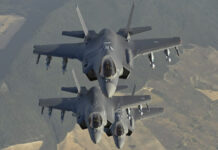The C-130J is the newest tactical inter-theater transport aircraft fielded with the US Air Force and several international air forces. capable of flying higher, farther and faster than previous C-130 models while carrying more cargo.
C-130Js are currently deployed in two combat theaters and are operating at a very high tempo efficiently and reliably. C-130Js are being used daily for troop and equipment resupply via ground delivery and airdrop, for air-to-air refueling, ground refueling and humanitarian relief. The worldwide fleet of C-130Js has now exceeded 350,000 flight hours. In the United States, Air Mobility Command, Air Education and Training Command, Air Force Reserve Command and Air National Guard units fly C-130Js, WC-130Js and EC-130Js. The Marine Corps operates KC 130J tankers and the Coast Guard flies the HC-130J. International C-130J operators include the Royal Air Force, Royal Australian Air Force, Italian Air Force and the Royal Danish Air Force.
In October 2006 AMC declared Initial Operational Capability for the C-130J. This approval followed successful demonstration of specific requirements for the C-130J, including completion of Qualification Operational Test and Evaluation (QOT&E), equipping the first combat delivery squadron to its full Primary Aircraft Authorized (PAA) limit with the ability to perform operational air-land missions, and manning one squadron of trained aircrews and maintenance members to support the mission. The Maryland Air National Guard’s 135th Airlift Group was the first combat delivery squadron to reach full PAA and also fulfilled the IOC manning requirement. Along with other C-130J units, the 135th AG has deployed to U.S. Central Command’s area of responsibility, performing airland and airdrop missions.
Lockheed Martin will upgrade the avionics and capabilities of C-130J Super Hercules transports flown by United Kingdom, Australia, Italy and Denmark. Focusing on avionics hardware upgrades, the package will include integration of communications, navigation, surveillance and air traffic management and identification (IFF) systems, terrain awareness warning system, providing both visual and audible cues, integration of a common flight management system, with improved data monitoring during takeoff and landing and installation of a robust, PC-based Data Transfer and Diagnostic System (DTADS) to enhance the aircraft diagnostics and health management. The aircraft will also receive an improved loading ramp and enhanced door hydraulics to support high altitude airdrops.
Known as Block 6.1 upgrade, the US$ 110 million program will enable these air-forces to collaboratively acquire enhanced capabilities for their aircraft while sharing the cost of development, design, test and integration.
The Canadian Ministry of Defense selected the C-130J as the future transport aircraft of the Canadian Air Force. Contract negotiations began last year after the selection was announced in November 2006. Canadian Defense Minister Peter MacKay announced the US$1.4 billion (C$1.428 billion) contract award on January 16, 2008, for the supply of of 17 tactical transport planes by Lockheed Martin. Earlier reports mentioned much higher costs for the program, assuming C$3.2 billion to be spent on procurement and additional C$1.7 billion for life cycle support. The C-130J will replace C-130 Hercules aircraft currently in service. Initial deliveries are expected within 24 months, by 2010.
Norway has requested to buy four C-130J aircraft, for a US$520 million. These aircraft will be equipped with teh standard fit of AAR-47 missile warning systems, ALR-56M advanced radar warning system, and ALE-47 CMDS. Communications systems will comprise ARC-210 and AAR-222 encrypted SINCGARS sets.
The Hercules will soon be augmented by the C-27J Spartan Light Transport Aircraft recently selected by the U.S. Army and the U.S. Air Force for the Joint Cargo Aircraft (JCA) program. The aircraft was designed by the Italian company Alenia Aeronautica (from the Finmeccanica group). The aircraft will be built and supported in the US by a team led by the L-3 Communications group, with team members Boeing Integrated Defense Systems (IDS), and Global Military Aircraft Systems (GMAS). The aircraft is a medium range, multifunctional transport aircraft, designed for logistical resupply missions, medical evacuation, troops transport and airdrop operations. The aircraft will support U.S. Army and U.S. Air Force operations, including force projection, humanitarian assistance and homeland security. The Spartan will replace the Shorts C-23 Sherpas, C-12 and C-26 aircraft.




















